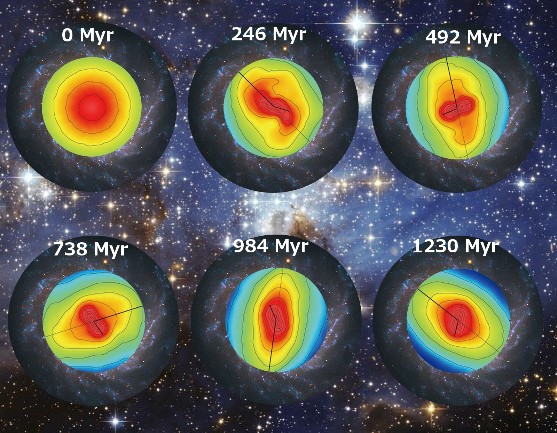The Milky Way Galaxy, our home, is not just a spiral galaxy, but a barred spiral. About two thirds of spiral galaxies are classified as barred spirals, among which one type is even more special by hosting two bars. These are termed spiral galaxies with two bars (S2B in short. In Chinese, 2B often means being idiotic when it is used to describe one’s behaviors. So one joke from this name “S2B” seems to mean the “idiotic” galaxies).
Being special does not mean that they are rare. Actually, optical and infrared observations have shown that about one fourth of early-type barred galaxies are S2Bs.
The two bars of a S2B, with different sizes, rotate independently and interact with each other. Dynamically decoupled secondary bars in S2Bs have been hypothesized to be a mechanism for driving gas toward the center of galaxy to feed the supermassive black hole lurking there.
Astronomers still don’t understand how spiral galaxies get two bars. Some previous theories require the existence of gas for forming and decoupling the secondary bar. This view is not, however, universally accepted and some recent works have produced secondary bars without the direct effect from gas.
A PhD student, Min Du, at Shanghai Astronomical Observatory (SHAO), working under the supervision of Professor Juntai Shen from SHAO and Professor Victor P. Debattista from UCLan, demonstrated a new approach for generating secondary bars. By exploring a large parameter space of isolated pure-disk simulations, they showed that a dynamically cool inner disk embedded in a hotter outer disk can naturally generate a steady secondary bar while the outer disk forms a large-scale primary bar. This new work has been published in the recent volume of The Astrophysical Journal.

Figure: The time evolution of the simulated S2B simulation at various times. Colors from red to blue refer to decreasing density. Short and Long straight line mark the secondary and primary bar respectively. Background image credit: NASA, ESA, STScI/AURA. Individual galaxy background image credit: ESO
Our method has not considered the direct effect from gas, showing that the secondary bar can be formed from pure disk instabilities,” said Du Min. “Such simple and natural forming conditions imply that small-scale secondary bar should be lurking in barred galaxies, even though we have not observed such “tiny” structures at high redshift because of the smaller sizes.”
How would these “tiny” structures grow? Prof. Shen explained, “There are several possibilities. Some may grow longer and larger by accreting matter and finally being transformed from S2Bs to commonly observed single bar spiral galaxies. It is possible that through interactions, the secondary bar would be captured by the primary bar and finally coupled together. In all, only a few S2Bs are stable until now.”
It is generally thought that gas is driven from outside in (a possible channel is provided by the primary bar), accumulation of gas giving rise to a cool disk that may be able to form a nuclear bar.
Prof. Debattista said, “with this work we have now demonstrated another method for forming double-barred galaxies without needing to resort to gas. The S2B phenomenon therefore is a phenomenon that requires the stars in the inner galaxy to be rotating differently from those further out.”
“In our alternative formation scenario, the secondary bar may form from the violent clumpy phase in the early universe when the primary bar is still not formed.” Prof. Shen concluded, “in many numerical simulations, these clumpy-origin small-scale bars could be easily mistaken as bulges. Therefore, the question remains whether the small-scale bar instabilities happens at the early time of the galaxy formation or after the formation of the primary bar. To better understand the formation of S2Bs, further simulations are required.”
Link to the research paper:
http://iopscience.iop.org/0004-637X/804/2/139/
News contact: Wenwen Zuo, wenwenzuo@shao.ac.cn, 34775125
Science contact: Juntai Shen, jshen@shao.ac.cn